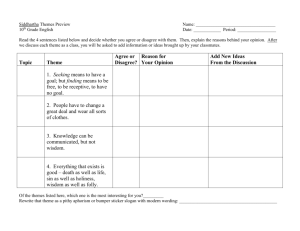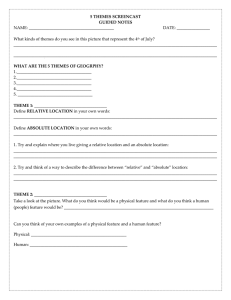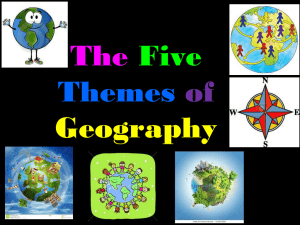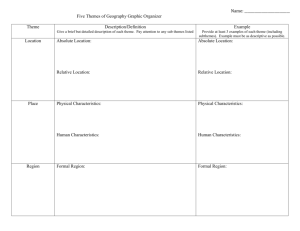File - learningenvironmentportfolio
advertisement
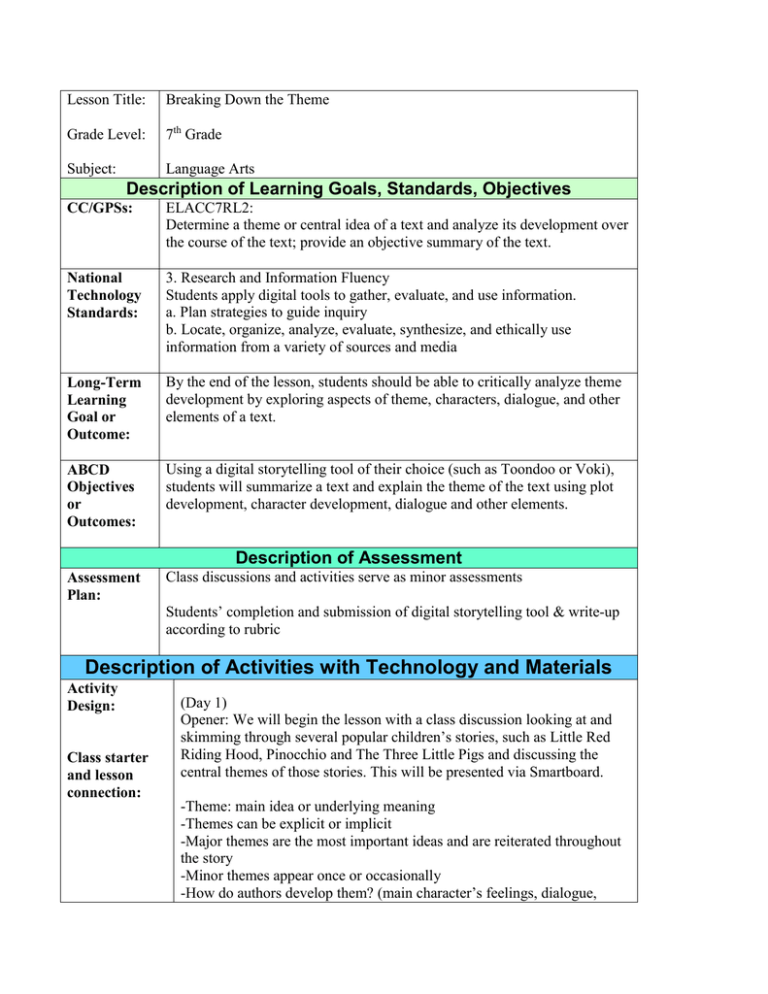
Lesson Title: Breaking Down the Theme Grade Level: 7th Grade Subject: Language Arts Description of Learning Goals, Standards, Objectives CC/GPSs: ELACC7RL2: Determine a theme or central idea of a text and analyze its development over the course of the text; provide an objective summary of the text. National Technology Standards: 3. Research and Information Fluency Students apply digital tools to gather, evaluate, and use information. a. Plan strategies to guide inquiry b. Locate, organize, analyze, evaluate, synthesize, and ethically use information from a variety of sources and media Long-Term Learning Goal or Outcome: By the end of the lesson, students should be able to critically analyze theme development by exploring aspects of theme, characters, dialogue, and other elements of a text. ABCD Objectives or Outcomes: Using a digital storytelling tool of their choice (such as Toondoo or Voki), students will summarize a text and explain the theme of the text using plot development, character development, dialogue and other elements. Description of Assessment Assessment Plan: Class discussions and activities serve as minor assessments Students’ completion and submission of digital storytelling tool & write-up according to rubric Description of Activities with Technology and Materials Activity Design: Class starter and lesson connection: (Day 1) Opener: We will begin the lesson with a class discussion looking at and skimming through several popular children’s stories, such as Little Red Riding Hood, Pinocchio and The Three Little Pigs and discussing the central themes of those stories. This will be presented via Smartboard. -Theme: main idea or underlying meaning -Themes can be explicit or implicit -Major themes are the most important ideas and are reiterated throughout the story -Minor themes appear once or occasionally -How do authors develop them? (main character’s feelings, dialogue, events, etc) Teacher and student activities: Students will then be divided into groups and given a story to work on. In groups, each student will be asked to change one event/detail in the story and group rethink the theme as well as explore the “major” and “minor” themes in the text. Students will submit one piece of paper for group indicating the “change” each student made. Students will work in groups initially while teacher walks around and engages/questions students; teacher then facilitates larger class discussion, asking each group to share one example. Through this activity, students will explore the subjectivity of theme and learn there may be multiple themes as well as analyze how plot affects theme development. Technology Connection: (Day 2) While working in same groups, students will be asked to build on previous day’s activities by applying same technique to books read in class (Higher Power of Lucky, The Watsons Go To Birmingham, The Boy in the Striped Pajamas, The Giver) and analyze the theme. Students will compose write-up with group containing summary, supporting details, and example of changed detail as specified in rubric. Then class will go to computer lab to begin digital storytelling that will be due next day for group presentations. Students will need typed summary from group activity and digital storytelling tool (worked on during class); students may also use books. Materials and Resources: Teacher will provide example to class when explaining assignment and expectations. Exemplar 1-Voki: http://www.voki.com/pickup.php?scid=8364527&height=267&width=200 Exemplar 2: ComicLife Reflection on Lesson Design Future Actions: One of my main concerns/challenges was attempting to incorporate Bloom’s Taxonomy and trying to think outside of the box in order to encourage the students to do the same. If I had more time, I would probably allow the students to explore other digital storytelling tools to use for assignment and have them briefly present/explain those to the class. The technology artifact, because it requires one’s own text, demonstrates how much a person has read/understands the text. It also gives students some creative license to edit voices and characters. The activities and technology center around lesson objective of theme and summarization; this makes sure students are constantly thinking about what is going on in the text and the elements that add to theme development.
